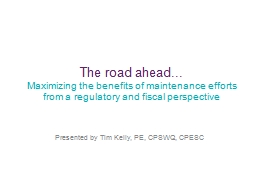

Agenda The Real Worth of Maintenance Activities Pond Cleaning Ditch Cleaning Street Sweeping Litter Control FDOT Personnel Awareness of NPDES 2 What comes to mind when you see this Costly maintenance ID: 1030021
Download Presentation The PPT/PDF document "The road ahead... Maximizing the benefit..." is the property of its rightful owner. Permission is granted to download and print the materials on this web site for personal, non-commercial use only, and to display it on your personal computer provided you do not modify the materials and that you retain all copyright notices contained in the materials. By downloading content from our website, you accept the terms of this agreement.
1. The road ahead...Maximizing the benefits of maintenance efforts from a regulatory and fiscal perspective
2. AgendaThe Real Worth of Maintenance ActivitiesPond CleaningDitch CleaningStreet SweepingLitter ControlFDOT Personnel Awareness of NPDES2
3. What comes to mind when you see this?Costly maintenance?Something that can “wait another year”?$$ out with seemingly temporary benefit?How about regulatory (and $) CREDIT for a “valuable by-product”?3
4. Maintenance Unit/District Save Big $$$ By Keeping Track Of All Completed Maintenance That Affects Stormwater RunoffHow does this work?First, all FDOT Districts have impaired waters, TMDLs, and therefore pollutant load reduction requirements.Many TMDLs are for nutrients: Total Nitrogen and Total Phosphorus.The TMDL is based on reducing pollutant loads from a “referenced condition” which inherently accounts for how MS4 operators, such as FDOT, have been doing business. Therefore truly “routine” maintenance is accounted for in the TMDL.4
5. What does the regulatory gun look like?EXCERPT FROM A TYPICAL NUTRIENT TMDL:5
6. 6MS4s (FDOT, Cities, Counties) can achieve Nutrient Pollutant Load reduction credits by:Construction of new stormwater BMPsImplementation of additional maintenance activitiesDocumentation of non-routine maintenance activities
7. Compare new BMP Construction Costs vs. Maintenance Costs7Source: Quantifying Nutrient Loads Associated with Urban Particulate Matter (PM) and Biogenic/litter Recovery through Current MS4 Source Control and Maintenance Practices, Univ. of Florida, Sansalone, et al, May 31, 2011
8. So what information is required from your maintenance forces? Let’s start with clearing and grubbing workVolume of material removedDescription of materialYour District NPDES Coordinator can obtain:Nutrient value of the material removedVegetative SedimentDensity of materials8
9. Example laboratory print-out of cleared and grubbed material from wet detention ponds9
10. Nutrient load removal calculation for pond clearing and grubbing contractTons of vegetation/vegetation detritus removed- convert to kg of material removed(x kg of material) x (mg of TP or TN/kg of material) = total TP or TN removed from the systemExample: Summary of a 2012 District contract for clearing and grubbing8 Ponds/4.6 acres total/6350 cy hauled6350 cy PM 656,200 to 1,653,000 lbs PM (Vegetation/Sediment % varied) 4,052 to10,212 lbs TN & 181 to 456 lbs TP$107,223 including clearing/grubbing and MOB, resodding berms, etc.Costs of nutrient removal: $10.5 to $26.5/lb TN and $234 to $592/lb TP Land costs and constructing 4.6 acres of similar ponds may cost about $2-5 million, depending on land costs10
11. Nutrient load removal benefits occur with ditch cleaning and pipe desiltingThese activities also provide pollutant load reductionsWeight or volume of material is always the most usefulMMS units are linear feet cleaned, therefore average yield rates (CY/LF cleaned) can be tracked and used as secondary estimateSuch maintenance activities are not “annual”. That’s okay, let the NPDES coordinator figure out how to get the credits for this work.11
12. Street SweepingLet’s revisit the average costs for nutrient removal from various BMPs12Source: quantifying nutrient loads associated with urban Particulate Matter (PM) and biogenic/litter recovery through current MS4 source control and maintenance practices, Univ. of Florida, Sansalone, et al, May 31, 2011
13. Highlights of the UF StudyMedian of the PM recovery from street sweeping is 147 dry kg PM/mile sweptStreet Sweepings: Median is 361 mg TP/kg PM and 563 mg TN/kg PM (independent of land use)13
14. Tons or cubic yards of street sweepingsMoisture content is needed and can be estimated(CY of dry material) X (density of material, lb/cf) x ( 361 mg TP/kg PM swept- from study) x (conversion factor) = total TP removed from the system.Example: Actual District contract for sweeping in an urban cityContractor reported 125 tons per month swept from SHS12 x 125 tons = 1500 tons (3,000,000 lbs) PM annuallyMunicipality reported 9.9% moisture content 3,000,000 lbs (gross weight) 2,703,000 dry lbs annually2,703,000 lbs x 361 mg/kg PM x conv. factor = 976 lbs/yr TP removedContract was worth $183,966 annuallyNutrient removal costs: $188.5/lb TP and $120.90/lb TNNutrient load removal calculation for street sweeping contract14
15. Summary about street sweeping15A good “source” control BMP that is very cost effective.FDOT Districts are relying on street sweeping load reductions for many of their Basin Management Action Plan commitments for annual load reductions.FDOT Districts are relying on street sweeping as a vital component of their stormwater management plans, particularly for roads in areas developed pre-early 1980s and having no stormwater treatment.
16. Adopt a Highway – Litter ControlThis is an MS4 permit element and is important not only to the NPDES regulator but should be to FDOT as well. Consider:5.25 trillion pieces of plastic estimated in the world’s oceans (269,000 tons)80% of marine debris comes from land-based sourcesMMS indirectly reports litter in acres under mowing activitiesAny activities removing litter should be reported to the NPDES coordinator when possible and volume or weight is the most useful16Source: Keep Tampa Bay Beautiful article in Tampa Bay Times, February 7, 2016
17. Awareness of the NPDES ProgramThe NPDES permitting authority (FDEP) and EPA can audit an FDOT office at any timeThe vast majority of permit “violations” are documentation issues and/or just plain lack of awareness (and therefore implementation) of the program requirementsSo, guess who is most likely to be questioned by the EPA or FDEP when an audit is conducted on an FDOT District Office….17
18. The person you may have least prepared...18